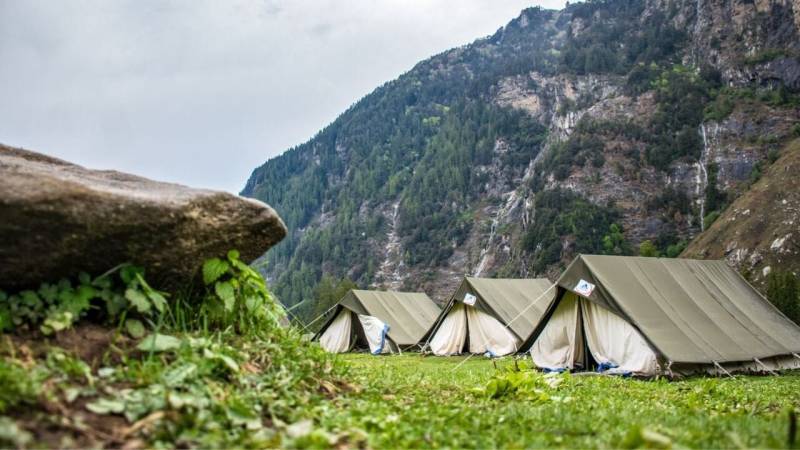
How to find the perfect location for your bushcraft camp?
👉 The key facts from this guide
- A good camping spot should be safe, comfortable, and environmentally friendly.
- You should always make sure that your camping spot is not near flood areas, rock walls, avalanche danger, or under trees.
- An ideal camping spot should receive morning sun and be in the shade in the afternoon.
- It is important to keep enough distance between your sleeping area and the campfire.
- You should set up your toilet at a distance of 150 to 200 meters from the campsite.
More than 65% of Bushcrafters and survivalists build a shelter, and 72% even spend the night in their camp.1
But where do we build our bushcraft camp? Or where do we just set up our tarp or tent?
What are dangerous areas for a storage area? And what are the ideal conditions?
Today, I want to clarify these questions, and you will learn which places to avoid and which are ideal for your camp.
What makes a good bushcraft campsite?
A good storage space is safe, comfortable, and environmentally friendly.
Two tips at the beginning:
- Good places are found, they are not made!
- Freshwater nearby is always an advantage.
But first, let's take a look at which places to definitely avoid!
Unsuitable Bushcraft, Tent, and Campsites
There are four important criteria that you truly must consider.
Flood Hazard
If you store too close to a river or lake, you are not safe from floods.
The worst thing would be if a flood occurs at night while you are sleeping.
The river or lake rapidly fills with water during rain and creates waterfalls and floodplains.
And remember: even if it's raining in the distance, a stream can quickly come to you. Therefore, always store away from water.
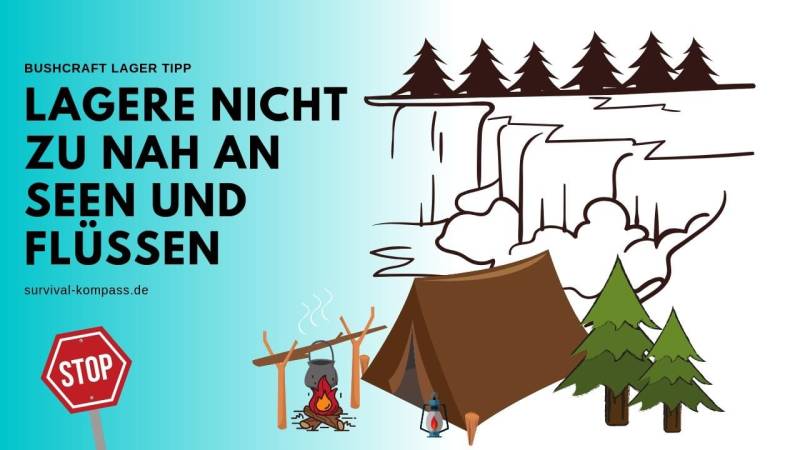
Under a rock wall
As soon as you see rubble, it's an alarm signal for you. Never store or camp under a rock wall, cliff, steep wall, or in front of a slope.
The danger of rocks breaking and rolling towards you is significant.
If there is no other option, then find at least trees for protection.
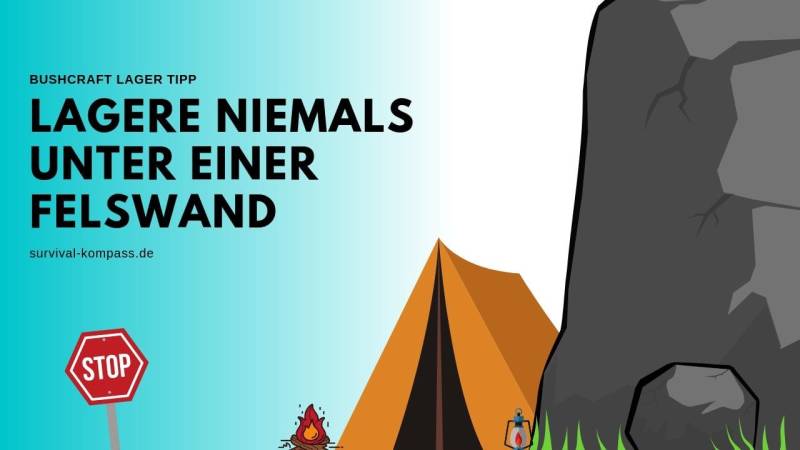
Avalanche Danger
As soon as it has snowed, avalanches can occur on steep slopes. Therefore, this place is not suitable for a camp, tent, shelter or stay.
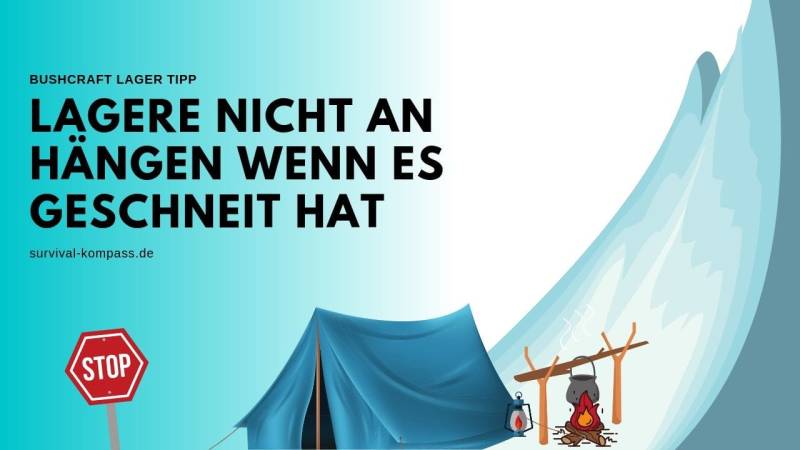
Under a Tree
A tree provides shelter and is a danger at the same time.
Even healthy-looking trees can suddenly drop branches. Due to a storm, animal infestation, or decay.
Therefore, always check if thick branches are directly above you. If so, keep your distance from them.
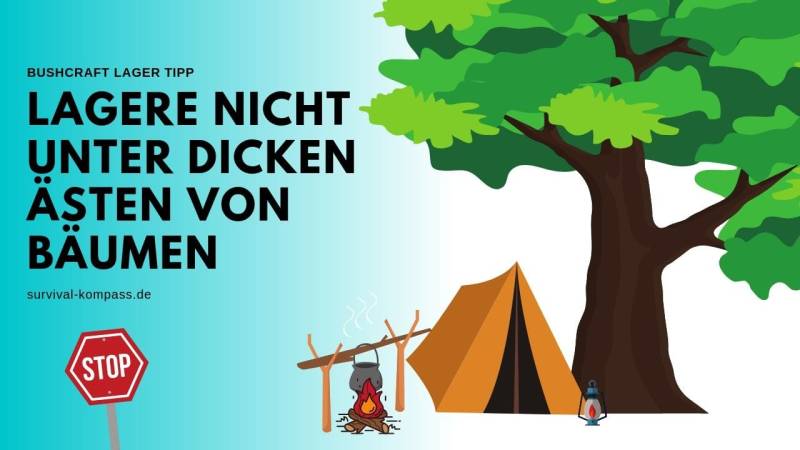
Reading tip: 6 trees every survivalist should know
The ideal bushcraft, camping, and campsite
You build a bushcraft camp so that it lasts longer. It's like buying a real house. Ask a real estate agent about the most important factor when buying a house. The answer: the location!
The same rule applies when setting up a bushcraft camp. You must find the optimal location.
I am now listing a few facts that I consider to be particularly essential.
|
Sun |
The sun brings warmth and confidence. Place your camp so that you get sun in the morning, and it is in the shade around noon. |
|
Wind |
As described above, trees are a wonderful protection against wind. But never pitch your tent directly under a tree. You can use the edge of a forest clearing. Furthermore, a rock, terrain edges or a fallen tree root can also offer protection. |
|
Moisture |
Check if you are in a depression. Moisture usually accumulates there, or it may even be an area that can be flooded. Protect yourself from moisture from above with a tarp, shelter or a proper roof. |
|
Terrain |
A flat spot is better than a rocky and hilly campsite. You will be able to run faster on a flat spot. You will also have to reshape terrain with stones in a laborious way. |
|
Fireplace |
Make sure there is enough distance between the sleeping area and the fireplace (about 3 meters). In my e-book, you will find 12 popular fire construction methods. |
|
Toilet / Latrine |
You should build your toilet at a distance of 150 to 200 meters from the camp. More on the topic "How I go to the restroom in the forest" can be found in my article. |
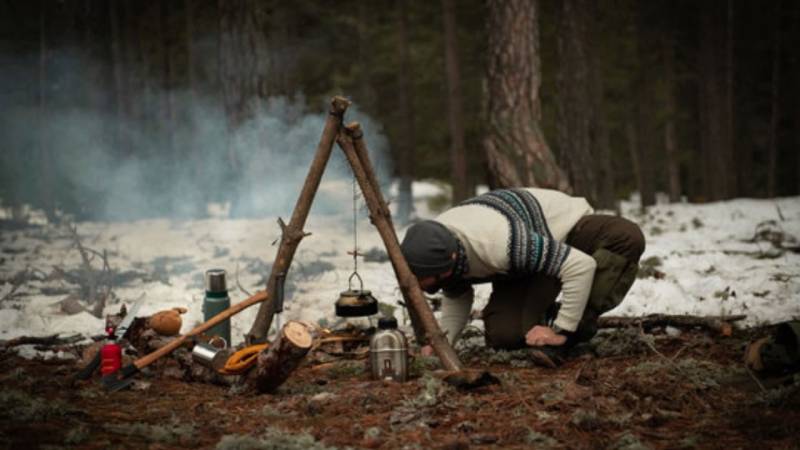
Where in Germany can you practice Bushcraft and Survival?
Now you know how important a good storage place is for your bushcraft camp. But where can you even try out your skills?
In Germany, there are many great places where you can let off steam. From the mountains in the south to the forests in the north, the country offers a varied landscape with numerous opportunities for hiking, camping, and exploring.
If you are searching for a place to test and develop your skills, I recommend taking a look at my website. There you will find the best places to practice bushcraft and survival techniques throughout Germany - from wild national parks to breathtaking lake landscapes.
So, what are you waiting for? Pack your backpack and get ready for your next adventure!
Read also
Bushcraft without frustration: These 12 mistakes you should avoid as a beginner – You are starting with bushcraft and want to avoid typical beginner mistakes? Here you will learn what pitfalls there are and how to avoid them.
Summary
So, as you can see, there is a lot to consider.
And be honest: Do you check for all these things at your seat? I haven't done it in a long time, but now I'm going through the points and feeling more confident.
It would be a disaster if an old, thick tree trunk crashed into the camp. Checking that takes a few seconds, right?
Take your current camp now and compare it with the table above. Have you considered everything? What can you improve?
Write your opinion in the comments now!

Sources for the guide
1 Michael Keop, https://michaelkoep.wordpress.com

Author of the guide
Martin Gebhardt
Hey, I'm Martin. On my blog, you will learn the basics and numerous details about living in the wild. I think survival, bushcraft and the good life in nature are the keys to happiness. Find me here on Instagram or on YouTube. You can find more about my mission on the About Me page.
Was this guide helpful?
49 people found this guide helpful.
4.92 out of 5 points (50 Ratings)
Comments (0)
This post may contain affiliate links. So if you click on the links and make a purchase, I will receive a small commission at no additional cost to you. Click here, to learn more about it.


